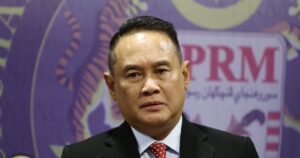WALK into a semiconductor factory in Penang, Kulim, or Johor today, and you can feel it: the hum of precision machinery, the glow of wafer lines, the almost reverential quiet of people making the world’s most complex products.
For decades, Malaysia has been a quiet workhorse in the global electronics supply chain – testing, packaging and shipping chips that end up in everything from iPhones to electric cars.
It’s the sort of quiet competence that rarely makes headlines but underpins trillions in global trade.
But the ground under those cleanroom floors is shifting.
The US-China tech rivalry has turned chips and AI into the new oil and gas – strategic resources fought over with tariffs, export bans and geopolitical posturing.
Supply chains that once flowed smoothly from design labs in Silicon Valley to fabs in Taiwan to assembly plants in Penang are being rewired in real time.
And that’s not all bad news. For countries nimble enough to move, it’s an opening.
Malaysia’s moment is here. With the National Semiconductor Strategy pledging at least RM25 billion in targeted incentives and aiming to train 60,000 engineers, the country has a real shot at climbing up the value chain – from back-end assembly to front-end design, advanced packaging, and specialised niches like silicon carbide (SiC) power devices.
Think of it like a relay race: for years, Malaysia has been running the final lap, taking the chip from others and getting it over the finish line.
Now, it has the chance to start the race at the first baton exchange and shape the outcome.
From Quiet Workhorse to Global Tech Player
The model is simple but ambitious: anchor advanced manufacturing clusters around Kulim’s power semiconductor push, Penang’s OSAT (outsourced assembly and test) ecosystem, and Johor’s rapidly growing data centre and AI infrastructure hub.
Infineon is already building what it calls the world’s largest 200 mm SiC power fab in Malaysia, a move that could put the country at the center of electric vehicle and renewable energy supply chains.
Industry leaders in Penang caution that the window of opportunity will not stay open forever.
If Malaysia fails to move decisively into higher-value segments like chip design, advanced packaging, and niche materials, it could remain trapped at the lower rungs of the global tech ladder for another generation.
The choice, they say, is between making the leap now or watching others climb ahead.
But the playbook isn’t just about building fabs. It’s about building brains.
Malaysia can’t afford to let the new AI supercomputers coming from the Nvidia-YTL partnership become mere showcase projects.
They should form the backbone of a sovereign AI infrastructure, open to startups, SMEs, and universities. Imagine a public “compute commons” where a manufacturing SME in Perak can fine-tune a Malay-language AI model for predictive maintenance, or where a port in Johor uses an AI copilot to shave hours off container handling.
And the hardware isn’t just for AI software. It’s a magnet for AI hardware manufacturing.
Data centres need racks, cooling systems, high-speed interconnects and optics. Those are supply chains Malaysia could own if it ties investment incentives to local manufacturing commitments.
Friendshoring as Malaysia’s Diplomatic Ace
In this bifurcated world, friendshoring isn’t a buzzword – it’s a passport.
Global tech companies are looking for countries where they can plant a flag without falling foul of export controls, sanctions, or geopolitical drama.
Malaysia has the credibility to play that role: politically stable, manufacturing-proven, and not in the direct firing line of either Washington or Beijing.
To make that pitch irresistible, Malaysia should roll out a “neutral zone” investment clearance programme – a one-stop shop that pre-screens projects for export-control compliance,
IP protection and guaranteed utilities. It should be as easy for a Taiwanese server maker or a German EDA software company to set up in Johor as it is for a Malaysian startup to register online.
Speed matters. Pre-permitted industrial parks with plug-and-play infrastructure – green power options, redundant fiber, bonded warehouses – would allow companies to move from signing to production in months, not years.
Singapore’s land scarcity is Malaysia’s land opportunity; Johor should be marketed as Singapore’s AI-and-semiconductor backyard.
The Loop That Could Power the Future
The real opportunity is to create a self-reinforcing loop: AI makes Malaysian factories more productive, those factories produce better chips, and those chips power better AI.
It’s the kind of flywheel effect that turns countries from supply chain stops into supply chain shapers.
But that loop won’t spin without people. Malaysia needs to fast-track critical-skills visas for chip designers, AI engineers and reliability specialists – paired with bonded scholarships and “earn-and-learn” programs inside anchor fabs.
TVET (technical and vocational education and training) must evolve from teaching generic manufacturing skills to training technicians who can run AI-optimized production lines.
And because both chips and AI data centers are resource-hungry, sustainability must be baked into the plan.
Require hyperscalers and fabs to procure renewable energy directly, pay a resource premium, and invest in water recycling and heat reuse.
In a country where energy and water stress are already flashpoints, this is not green virtue-signaling – it’s operational insurance.
There’s a reason the Economist Intelligence Unit ranked Malaysia as one of the most competitive emerging manufacturing hubs in Asia.
The fundamentals are here: geography, stability, a skilled base, and a history of manufacturing trust.
The danger is thinking that a single “moonshot” project – a big fab, a flagship AI centre – will be enough.
In truth, building Malaysia’s tech future is more like tending an orchard than firing a rocket: you need many plantings, constant care, and the patience to see them bear fruit.
If Malaysia can master that rhythm – moving fast, coordinating deeply, and keeping the flywheel spinning – it won’t just be part of the global supply chain. It will be part of the global story. And in the age of AI and geopolitics, that’s where the real power lies.
————————————————————–
*The writer is a public policy analyst, economist, and international relations commentator. He is an adjunct lecturer at Universiti Teknologi Petronas and a senior consultant with Global Asia Consulting. The views expressed in this op-ed are entirely his own.
© New Straits Times Press (M) Bhd





